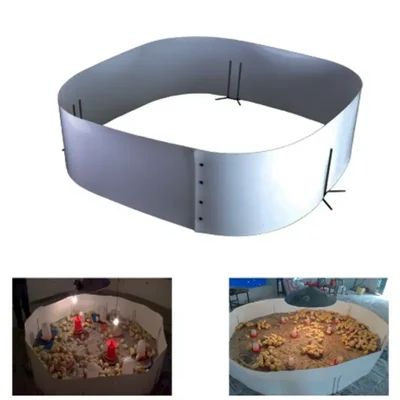- Farm & Garden
- Pumps & Motors
- Food Processing
- Workshop, DIY & MRO
- Lab & Measuring Tools

Brand: GKI POULTRY
GKI Poultry 15 Feet Plastic Round Chick Guard With 3 Stands & 300 Birds Capacity For Brooding
SKU: TI-PQ-11612
 57 people have bought this recently
57 people have bought this recently  Delivery By: Dec 23 - Dec 25
Delivery By: Dec 23 - Dec 25 





MRP : ₹1299 ₹1059
18% OFF!

 57 people have bought this recently
57 people have bought this recently  Delivery By: Dec 23 - Dec 25
Delivery By: Dec 23 - Dec 25 

Easy Return
& Refund
& Refund

Quality
Assurance
Assurance

Trusted
Delivery
Delivery

After Sales
Assistance
Assistance

Buyer
Protection
Protection
₹1059 (Including GST)
MRP : ₹1299
18% OFF!
Get Extra ₹16 OFF on Prepaid Orders
QTY :
-
1
+
Short Description
Round Guard For Poultry Chick
With 3 Stands & 300 Birds Capacity
15 Ft (457 cm) Chick Guard Length
Country of origin: India
Specifications
- Brand: GKI POULTRY
- Weight (Approx.) : 2.7 kg
- Material : Fabricated From the Finest Quality Plastic
- Size : 15 Feet (457 cm)
- Suitable For : 300 Birds (Approx.)
- Chick Guard Length : 15 Ft (457 cm)
- Chick Guard Height : 1.25 Ft (38.1 cm)
- Chick Guard Thickness : 1.5mm.
Description
Round guards on poultry farms are structures that protect chickens from predators and other potential hazards. These guards are usually round in shape and composed of strong materials. They are positioned around the perimeter of the poultry farm to form a physical barrier that prohibits unwanted entry and protects the animals. Additionally, round guards can also help to prevent theft and vandalism by restricting access to the farm.
Features
:- Shape and Design: The round design of the chick guard allows for a more natural movement for chicks. It creates a safe and secure environment that encourages them to stay close to the heat source while preventing them from wandering too far.
- Height and Size: The height of the round chick guard is usually low enough for chicks to easily navigate but high enough to prevent them from escaping. This balance ensures that young birds remain within a designated area without feeling trapped.
- Ease of Assembly: Round chick guards come with simple assembly instructions or can be set up quickly without requiring specialized tools. This ease of use makes them accessible for farmers who may not have extensive experience with poultry equipment.
Applications
:- Space Management: During the initial days of brooding, it is essential to manage space effectively so that all chicks have access to food and water while remaining close to the heat source. The chick guard helps organize this space by providing a defined area for the chicks, allowing them to move freely without straying too far from warmth and resources.
- Behavioral Monitoring: Using a chick guard allows for easier observation of chick behavior, which can indicate their comfort level and health status. If chicks are huddling together under the heat lamp, it may suggest they are cold; conversely, if they are moving away from the lamp, they might be too warm.
- Temperature Regulation in Brooding: A poultry chick guard is primarily used to create a controlled environment for newly hatched chicks. It helps maintain the necessary warmth by keeping the chicks close to a heat source, such as an infrared heat lamp.
Usage
:1. Preparation of the Brooding Area:
- Before placing the chick guard, ensure that the brooding area is clean, dry, and adequately prepared with suitable bedding material such as pine shavings or rice hulls.
- The brooder house should be warmed up to the appropriate temperature before introducing the chicks.
2. Setting Up the Chick Guard:
- Position the chick guard in the center of the brooding area where heat sources (like infrared bulbs or gas brooders) are located.
- Ensure that there is enough space within the guard for chicks to move freely while still being close to the heat source.
3. Introducing Chicks:
- Once you have set up the chick guard, gently place the newly arrived chicks inside this guarded area.
- It is crucial to do this promptly after their arrival so they can acclimate to their new environment and access warmth quickly.
4. Observing Chick Behavior:
- Keep an eye on how chicks behave within the guard. If they crowd together under heat sources, it may indicate they are too cold; if they pant or stay at the edges, they might be overheating.
- Adjust temperatures accordingly based on their behavior.
Maintenance:
- Regular Inspection: Inspect the chick guard regularly for any signs of wear and tear. Look for frayed edges, loose connections, or any damage that could compromise its integrity. If you notice any issues, repair or replace the damaged sections immediately to ensure the safety of your chicks.
- Cleanliness: Keep the area around the chick guard clean and free from debris. Regularly remove any bedding material that has become soiled or wet, as this can create an unhealthy environment for your chicks. Replace with fresh bedding as needed.
- Monitor Temperature: The chick guard should be positioned in such a way that it allows easy access to the heat source while keeping the temperature consistent within the brooder area. Ensure that there are no drafts affecting the temperature around the guard; this will help maintain a comfortable environment for your chicks.

Select attribute







